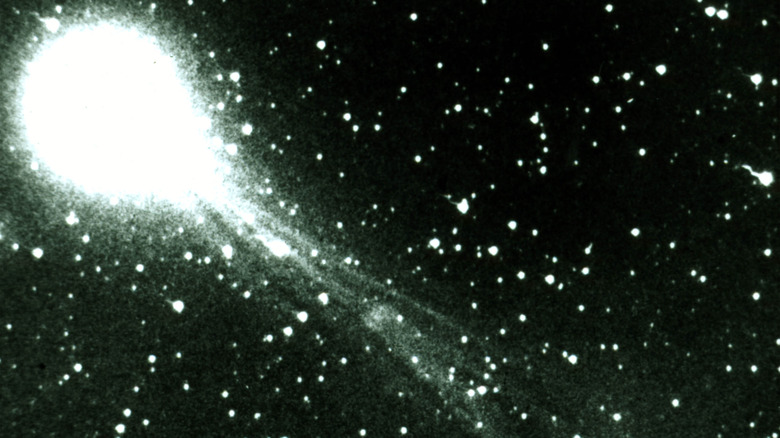Everything We Know About The Megacomet Headed For Earth
A huge comet is coming, but you might need to wait a while before it appears in the nighttime sky. The anticipation of seeing a megacomet, though, might merit the time. The Comet Bernardinelli-Bernstein (BB) sprawls across approximately 62 miles — the largest one ever seen, according to USA Today. It might even be bigger than that. Space reports that some estimates put it at 100 miles wide. Pedro Bernardinelli and Gary Bernstein of the University of Pennsyvlania identified the comet, which is named for them. Bernardinelli had recently defended his dissertation on another topic, trans-Neptunian objects. Bernstein also had another specialty, dark matter distortions. "This is an unusual honor for a cosmologist," Bernstein said to Space.com, "but my mother's very happy."
Besides its remarkable size, BB also became an active comet far away from the sun, which astronomers consider unusual, according to Science Alert. Usually comets occur when the sun's light warms its cold exterior, creating vapor from the ice and allowing dust and other substances to release. The haze that forms, known as a coma, offers information to astronomers about the comet's composition. BB is too far away still to discern specifics, but it is probable that the current mist surrounding it might consist of carbon dioxide.
Just one other active comet, albeit smaller, came from such a far distance from the sun. "These observations are pushing the distances for active comets dramatically farther than we have previously known," according to astronomer Tony Farnham from the University of Maryland, quoted by Science Alert.
BB's travels through the solar system
As they do with all comets, astronomers want to trace BB to its origins and figure out how it relates to our solar system's history. As technology improves, more information becomes available. "We have the potential of doing this a lot, once a comet is seen, going back through time in the images and finding them while they are at farther distances from the Sun," said Farnham, according to Science Alert.
The comet won't threaten Earth, says USA Today. Astronomers think the solar system always contained the comet and its origins go back to the Oort Cloud, a section of space that encompassed our solar system as well as the origins of another famous comet: Halley's (see photo above). The megacomet likely started its journey 3.7 trillion miles from the sun. It has moved slowly, progressing to 2.7 billion miles from our sun by 2014. The comet is currently 10 times bigger than the asteroid that allegedly toasted the dinosaurs. "The size estimate has no effect at all on the trajectory that the comet will take..." said Bernstein to USA Today. "There is no possibility of this thing getting any closer to Earth than Saturn gets."
BB, currently near Neptune, is expected to visit Saturn in 2031 before jetting off to more distant parts of the solar system. The closest it should get to Earth is about a billion miles. So no worries; human extinction via Comet Bernardinelli-Bernstein is not imminent.

